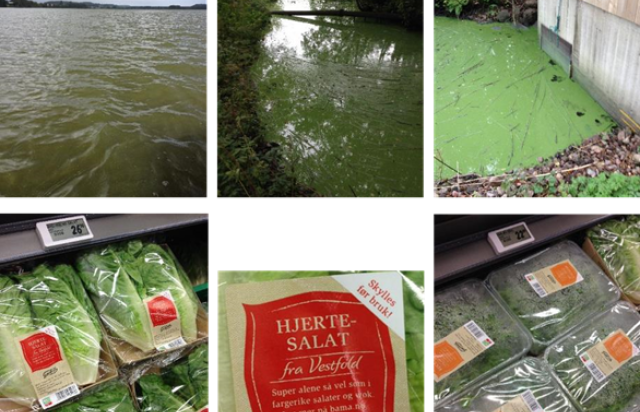BEDREVANN
In the BEDREVANN project, we will study the impact of cyanotoxin-contaminated irrigation water in agriculture and the risk to food producers and end users with Akersvannet in Vestfold as a pilot area. Akersvannet is a highly nutrient-rich lake with annual blooms of toxin-producing cyanobacteria. Water from the lake is used to irrigate surrounding agricultural areas where vegetables are largely grown, and this can pose a risk to safe food production.

About the project
Surface water from lakes or rivers is used extensively as irrigation water in Norwegian agriculture. Bacteria, viruses, parasites and undesirable chemical substances in irrigation water can cause disease if contaminated water is used to irrigate vegetables, fruit and berries. Using irrigation water with blooms of toxin-producing algae/cyanobacteria can contaminate the surface of leaves, fruit and vegetables, which can lead to human illness. Particularly at risk are lettuce and cabbage, but also strawberries and tomatoes where water can collect on leaf surfaces and leave a dried, concentrated residue of cyanobacterial biomass. Research has shown that dried cells from cyanobacteria can remain toxic for several months. Cyanobacteria can produce a number of substances, known as metabolites, several of which are various toxins (cyanotoxins). These toxins are heat-stable and are not deactivated by heat treatment. Cyanotoxins can damage the nervous system and liver in animals and humans and can in the worst-case lead to death.
Good quality irrigation water is important in Vestfold and Telemark, where there is large production of vegetables, potatoes and berries. Highly eutrophic lakes and polluted rivers can at times no longer be used for soil irrigation due to the presence of cyanobacteria and cyanotoxins. One example of such areas is Akersvannet in Tønsberg and Sandefjord municipalities. Akersvannet is a hypereutrophic lake that has a very high production of cyanobacterial and algal biomass during the summer months. Potentially toxin-producing cyanobacteria have often dominated the algae community in recent years and it is not uncommon to measure concentrations of the cyanotoxin microcystin that exceed the WHO's provisional guidelines for drinking water (1 μg L-1) and bathing water/recreation (24 μg L-1).
In the summer of 2015, there was a major bloom of the cyanobacterium Microcystis in Akersvannet. After a few days of strong northerly winds in August, large amounts of Microcystis biomass accumulated at the southern end of the lake where the intake to the soil irrigation system is located (Figure 1). NIVA measured very high concentrations of microcystin in samples from this biomass accumulation and there was concern that the cyanobacteria-rich water had been used to irrigate lettuce ready for harvest. Representatives from agriculture, the municipality, the county governor and the Norwegian Food Safety Authority assessed the situation and received technical input from NIVA. It was decided that the lettuce could be sold to consumers, but with additional labelling on the packaging "rinse before use" (Figure 1). Following this episode, Stokke Jordvanning has annually taken samples from Akersvannet at the intake of irrigation water to check for cyanobacteria and toxins.
To increase knowledge about the impact of cyanotoxin-contaminated irrigation water in agriculture and the risk to food producers and end-users, the BEDREVANN project wants to carry out a comprehensive research programme using Akersvannet as a pilot area. The affected food producers will be involved in the project, and the agricultural areas used will be mapped and investigated. BEDREVANN aims to develop an automated early warning system for toxin-producing cyanobacteria, which can support or replace current traditional monitoring. In addition, this system will enable early detection of possible contamination of food and drinking water and help avoid possible exposure of humans and animals. This is also important from an economic point of view, as producers can be alerted well in advance, thus avoiding possible loss of sales and protecting retailers and end consumers. The results are largely transferable to other agricultural regions in Norway.
Tønsberg municipality owns the project. NIVA is the project manager. The Veterinary Institute, NIBIO, and USN (University of South-Eastern Norway) participate in the project

 Andreas Ballot
Andreas Ballot
 Sigrid Haande
Sigrid Haande
 Birger Skjelbred
Birger Skjelbred
